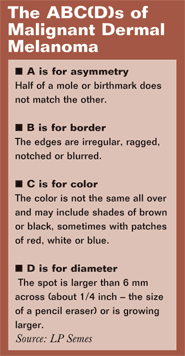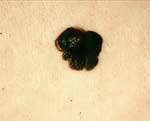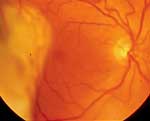Differential diagnosis of ocular melanoma vs. choroidal nevus is crucial
Click Here to Manage Email Alerts
|
| |||
A diagnosis of ocular melanoma can lead to grave outcomes, including enucleation and systemic spread. Considering the potential progression of this condition, it is important for a practitioner to differentiate between ocular melanoma and choroidal nevus, because the two can be easily confused.
According to John A. McCall Jr., OD, a Primary Care Optometry News Editorial Board member in private practice in Crockett, Texas, the Optomap (Optos North America, Marlborough, Mass.) is a very useful tool in differentiating these two anomalies.
“The Optomap has become, in my opinion, one of the best tools for differentiating choroidal nevus from melanoma,” Dr. McCall told Primary Care Optometry News. “It takes its image by using a green and red laser.”
When looking at the red laser, Dr. McCall said, the practitioner will be looking directly at the choroid. “Whether it is a melanoma or a nevus, it is going to be extremely dark and very visible when you are viewing the choroid only,” he said. “And then when you look at the green laser, which shows only the retina, a choroidal nevus will completely disappear. A melanoma will be just as dark and will have fuzzy edges.”
Other methods of diagnosis
According to Leo P. Semes, OD, FAAO, an associate professor at the University of Alabama, Birmingham, and a Primary Care Optometry News Editorial Board member, direct observation continues to be the mainstay of intraocular melanoma diagnosis. “This means fundus evaluation stereoscopically through a dilated pupil,” he said in an interview. “In the absence of clear media, ultrasonography is helpful.”
Jeffry D. Gerson, OD, FAAO, an optometric retinal specialist who practices in Kansas City, Mo., said the first approach to making the differential diagnosis is clinical exam by ophthalmoscopy to identify a lesion. “This should be able to tell us if the lesion is flat or raised, whether there are drusen (a sign of chronicity), whether there is any surrounding detachment and the general size of the lesion,” he said. “After a lesion is identified by clinical exam, the next steps are ultrasound, possibly fluorescein angiography and imaging, likely by MRI.”
The B-scan ultrasound will determine the approximate size of the lesion, including vertical and horizontal dimensions, Dr. Gerson said. A-scan will help to detect the amount of internal reflectivity, which is also helpful to diagnosis, he said.
“Fluorescein angiography will identify whether the lesion has its own, distinct tumor circulation. It may also show a typical tumor flush,” Dr. Gerson said. “Imaging, again most likely with MRI, will also give an approximation of size. Just as importantly, it will show if there is an uptake of gadolinium dye.”
Dr. Gerson said tumors are metabolically active and, for this reason, take up more dye than surrounding normal tissues.
Dilation and new technology
According to Jerome Sherman, OD, FAAO, a Primary Care Optometry News Editorial Board member based in New York, only about half of all optometrists regularly perform dilated exams of the fundus. “Approximately 40% dilate routinely,” he said in an interview. “And if you don’t dilate, you have a better chance of missing [melanoma].”
For this reason, Dr. Sherman, in private practice at the Eye Institute and Laser Center, feels the Optomap is very useful in detecting ocular melanoma. “If you do the Optomap, which can be performed without dilating, there is a very small chance of missing it,” he said. “You can view the entire fundus at once.”
|
Images: J Sherman |
|
Prognosis and management
The prognosis for ocular melanoma is not necessarily as grave as it may have been in the past, with newer treatment approaches now available. “In years past, the prognosis was immediate enucleation,” Dr. McCall said. “Now, there are a number of treatments, such as radiation seed therapy, that essentially seal off the melanoma to save the eye.”
|
Image: R Gutner |
However, the success of this type of treatment depends heavily upon whether the lesion is the only melanoma in the body. “This is a risk factor that could prove to be fatal,” he said. “If there is a metastasis elsewhere in the body while you are attempting to save the eye, it can potentially cause death.”
He recalled a patient who was treated with this technique, but who had a further metastasis in another part of the body. The patient died.
“There is no proof that death would not have occurred anyway, but you have to wonder if it would have happened if the eye had been immediately enucleated,” he said. “So, it’s still a judgment call.”
Dr. Sherman said the size of the lesion at the time of diagnosis factors into the prognosis, particularly in terms of the spread of cancer. “One of the numbers I have heard quoted by ocular oncologists is that if the eye tumor at the time of diagnosis is greater than 1 cubic centimeter, a high probability exists that there has already been micro-metastasis to the liver,” he said. “So the larger the lesion, especially when it is larger than 1 cubic centimeter, the higher the chance that it has already spread to the liver.”
Dr. Gerson said the prognosis for ocular melanoma, particularly in terms of morbidity, depends upon the histology of the lesion. “The problem is that we usually do not have the histology of the lesion, unless the eye is enucleated,” he said. “Biopsies are not done on intraocular lesions, because this may cause seeding into the vitreous and systemic spread.”
Dr. Gerson said tumors with larger bases are more likely to spread, due to the higher degree of contact with the highly vascular choroid. “There are three types of cells generally found in these tumors. They are spindle, epithelioid and mixed. The 5-year mortality for them is approximately 15%, 85% and 50%, respectively,” he said. “Additionally, tumors that rapidly shrink a great deal often have a poor prognosis, as they may also come back quite rapidly.”
Link between dermal, ocular?
With the rate of dermal melanoma on the rise, it is particularly important for optometrists to be vigilant for signs of melanoma in the eye.
“Certainly, if a patient has skin melanoma, it can metastasize anyplace,”said Dr. Sherman. “If an optometrist knows that a patient has had a skin melanoma, he or she clearly should do a dilated exam and a visual field and look at the eye. I think there is justification for that.”
Currently, there is little evidence in the literature to substantiate a link between the increased prevalence of dermal melanoma and the incidence of ocular melanoma.
“What we know about cutaneous and ocular melanoma is that they are different animals, or at least beasts of different stripes,” said Dr. Semes. “Dermal lesions are well-known to be potentiated by exposure to UV radiation. Because this portion of the spectrum is absorbed largely by the anterior segment structures, there is little opportunity for uveal absorption.”
A study published in the August 1976 issue of the Archives of Ophthalmology involved a histopathologic examination of the eyes of 15 consecutive patients with metastatic malignant melanoma. The study found that metastatic malignant melanoma arising in the skin demonstrated evidence of intraocular metastasis in five patients. The metastases were microscopic, epithelioid and minimally pigmented, and they occurred in both the choroid and retina.
According to Dr. Gerson, recent findings do not validate a correlation between the rates of dermal melanoma and choroidal melanoma.
“There really has not been an increase in choroidal melanoma to go along with dermal melanoma,” he said. “According to an article in Ophthalmology in May 2004 by Singh and Topham, the rate of uveal melanoma has not changed during the past 25 years and is consistent between here and Europe. The incidence is approximately 4.3 new cases per million population.”
|
Images: J Sherman |
|
Incidence in whites vs. blacks
Dr. Sherman pointed out one factor that may appear to link the two types of melanoma: the rate of its occurrence in white vs. black patients.
“It is fairly rare in black patients,” he said. “Melanoma in the eye is only about one-tenth as common in black patients than in white patients. So white patients are roughly 10 times as likely to develop an ocular melanoma.”
While Dr. Sherman maintains that this does not directly link the rate of the two melanomas, there does seem to be a common protective factor among black patients. “It is interesting that black patients seem to be protected both from skin melanoma and ocular melanoma, although I don’t think anyone is actually going to be able to show a parallel between the two,” he said.
For Your Information:
- John A McCall Jr., OD, is senior vice president of vendor relations for Vision Source. Dr. McCall can be reached at 711 East Goliad Ave., Crockett, TX 75835; (936) 544-3763; fax: (936) 544-7894; e-mail: vsourcejam@aol.com.
- Leo P. Semes, OD, FAAO, can be reached at 1716 University Blvd., Birmingham, AL 35294-0010; (205) 934-6773; fax: (205) 934-6758; e-mail: lsemes@icare.opt.uab.edu.
- Jeffry D. Gerson, OD, FAAO, can be reached at 4321 Washington Blvd., Ste. 5000, Kansas City, MO 66213; (816) 756-5900; fax: (816) 756-5457. Drs. McCall, Semes and Gerson have no direct financial interest in the products mentioned in this article, nor are they paid consultants for any companies mentioned.
- Jerome Sherman, OD, FAAO, can be reached at SUNY College of Optometry, 33 West 42nd St., New York, NY 10306; (212) 780-5004; fax: (212) 780-4980; e-mail: jsherman@sunyopt.edu. Dr. Sherman is the principal investigator of a study funded by Optos and has lectured for the company.






